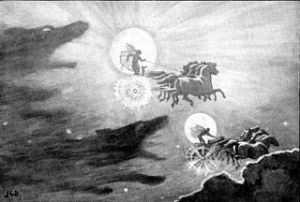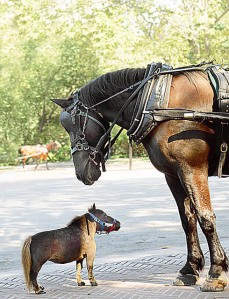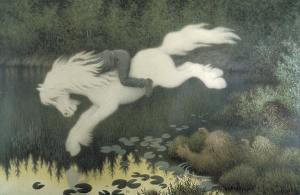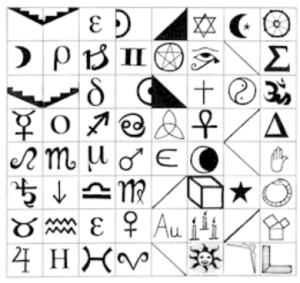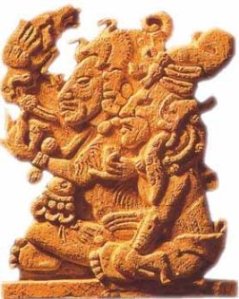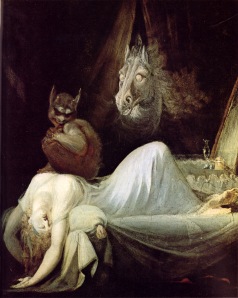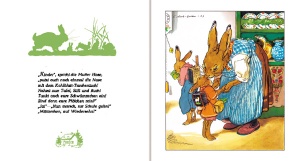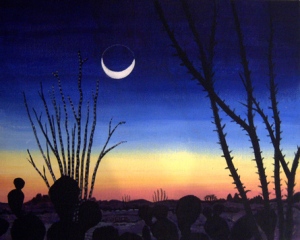written and copyrighted by Týra Alrune Sahsnotasvriunt
Alongside the multitude of deities in Germanic Paganism there are several other beings of importance, which are all too often overlooked.
The horse is an especially sacred animal in the Northern traditions, particularly to the Saxons.
Horses attested to in Lore
Sleipnir
There is, of course, the most famous horse Sleipnir, the eight-legged son of Loki. Unlike his siblings Fenris, Hel and Jörmungand, he is not met with general hostility. This is the story of his conception:
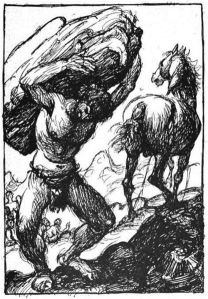 Blast, a Hrimthurse (frost giant) was asked to build an impenetrable wall around Asgard. As payment he asked for the giant siblings Sunna (the sun), Mani (the moon) and – should she have him – Wanen Goddess Freija, hostage of the Asen deities.
Blast, a Hrimthurse (frost giant) was asked to build an impenetrable wall around Asgard. As payment he asked for the giant siblings Sunna (the sun), Mani (the moon) and – should she have him – Wanen Goddess Freija, hostage of the Asen deities.
The Asen pretended to agree to Blast’s terms, but resorted to threatening Loki with a painful death if he didn’t find a way to cheat the great builder out of his payment.
Svadilfari (“Unlucky traveler”) was the name of the Thurse’s horse that helped him carry the heavy boulders used to build the Asgardian walls.
Loki turned himself into a female horse, luring away Svadilfari from his master and mating with him in the forest. The story’s end varies from culture to culture. Here we know that despite being delayed by the absence of his horse Svadilfari the great builder still finished Asgard’s walls on time. Outraged, Wotan and the rest of the Asen Gods sent Thunar to murder the Hrimthurs. Another story is that they murdered him only after finding out he belonged to the race of giants.
Shortly afterwards Loki gave birth to Sleipnir (“Swift Glider”) who – according to different stories – was either claimed by or given to Wotan as a gift.
Sunna’s Horses
Many other horses are attested to in the lore. Amongst them are Alswinn (“Very swift one”) and Arwark (“Early Guard”), Sunna’s horses. Then there are the Goddess Dag’s (“Day”) horse Skinfaxi (“Shining Mane”) and Hrimfaxi (“Frost Mane”) who belongs to the Goddess Nótt (“Night”).
In 1902 a Bronze age artifact was unearthed in the Moor of Trundholm in Sjelland, Denmark. As can be told from the image below this sun chariot has six wheels (Could this possibly be linked to the sixth rune of the Futhark, Kenaz, the fire-sun of life?) and carries one large disk which strikingly resembles the sun itself – the Goddess Sunna.
In the Nibelungs we have Goti, Gunther’s (Gunnar/Gundahar) horse that refused to pass Brünhild’s ring of fire and famous Siegfried’s (Sigurd) Grani, a descendent of Sleipnir. The name Grani has been translated as “Grey” but also as “Conifer” (even today the word gran means conifer in the Scandinavian languages.) The latter translation would point to a connection with Saxnot-Týr and the world yew tree Yggdrasil.
There are those horses belonging to humans, Beli, Falhofnir (“Fallow hooves”), Skeidbrimir (“Snorting”), Swedish King Adil’s horse Slöngwir and King Ali’s horse Hrafn (“Raven”).
Giants’ Horses
The horses of giants like Gullfaxi (“Golden Mane”) who belongs to the giant Hrungnir (“Hunger”), the giant who challenged Wotan to a horse race and who was then murdered by Asgardian Thunar.
 There is even a giant with the name of Hrosstjofr, simply meaning “Horse Thief”.
There is even a giant with the name of Hrosstjofr, simply meaning “Horse Thief”.
A German folktale from the Harz region knows of the giant Bodo who had a run-in with Brünhilde in the forest.
He wanted her for a wife, but terrified, she fled on her horse. Bodo, also on his giant horse, chased after her.
Finally, Brünhilde reached a great ravine. As Brünhilde preferred death over being married to a giant she forced her mare to leap, but instead of falling into the divide they both safely landed on the other side.
 The impact had been so severe that until this day you can see Brünhild’s horse’s hooves on the “Roßtrapp” stone.
The impact had been so severe that until this day you can see Brünhild’s horse’s hooves on the “Roßtrapp” stone.
On the other hand Bodo and his horse – too heavy for the jump – had both fallen into the ravine. All he has left of Brünhilde is her crown that she had lost during the fall. He is still holding on to it and keeps everyone who attempts to dive to the ground of “Bodo River” (Bode) in order to retrieve it in his watery grave.
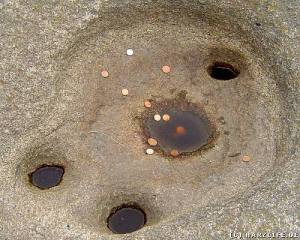 There are even children’s books loosely based on or inspired by this tale such as “The Giant and the Nymph” (Der Riese und die Nixe) from the 60’s.
There are even children’s books loosely based on or inspired by this tale such as “The Giant and the Nymph” (Der Riese und die Nixe) from the 60’s.
Dwarves’ Horses
One of the known dwarves’ horses is Verdrasill, usually translated as “Path-Horse” but possibly meaning Earth-Horse, which appears to make a little more sense.
Asen Horses
The horses of the Asen we know of are Gisl (“Whip”), Glad (“Happy”), Heimdall’s Gulltopp (“Golden Braid” NOT Golden Mane!), Gna’s Hofwapnir (this could mean “He who throws his Horse-Shoes” but it could also mean “Farmyard Protector”), Lettfetti (“Lightfoot”), Silfintopp (“Silver Braid”) and Sinir (“Sinewy”).
*
Horses, Magic and Shamanism
Horse Blessing
Northern polytheistic Shamans use the ancient “Horse Blessing” (Pferdesegen) to this day. In recent years the medieval rock band In Extremo has turned the Pferdesegen into a song quite popular on our Medieval Fairs.
The Original Text (plus translation):
Fonna demo uelle in diz tulli
Gang ut, nesso, mid nigun nessiklinon
Ut fana themo marge an that ben
Ut fan themo bene an that flesg
: Ut fan themo flesgke an thia hud
Ut fan thera hud an thesa starla :
Gang uz, nesso, mit niun nessinchilinon
Uz fonna demo marge in deo adra
Uonna den adrun in daz fleisk
Fonna demu fleiske in daz fel
: Ut fan themo… :
Translation:
Crawl out,
Worm, with nine other worms,
From marrow into vein,
From vein into flesh,
From flesh into skin,
From skin into hoof. (Literally: sole of the hoof)
Crawl out, Worm,
with nine other wormies,
From marrow into bone,
From bone into flesh,
From flesh into skin,
From skin onto this arrow head.
So you can be shot far away.
There have been countless (fruitless) attempts at making sense of the Horse Blessing intellectually and several German shamans have warned academics that this is something to be understood “with the heart and soul only”. Of course, the questions are valid and remain: Why 10 worms all in all? Was the Horse Blessing only meant for horses or for men as has been stated before?
Runes
Whatever the answer, one thing that is for certain is that horse and man have a deep (spiritual) connection in the Germanic belief system(s). Even in rune lore we don’t only have Raido, literally ride, but find that Mannaz (“Man”) is strikingly similar to the Ehwaz rune (“Horse”). Maybe because “Marr er manns Fylgja” (Mare is man’s Guardian Spirit see https://paganmeltingpot.wordpress.com/2014/09/06/the-fylgjen-guardian-animal-spirits/) was the motto of several Germanic tribes, and especially the Saxons, the “horse people” as they often called themselves.


Ehwaz is etymologically related to the Eiwaz rune also known as “Eo” or “Eolh”; eoh in Old High German means horse. This would complete the yew world tree/Shamanic horse travel circle.
Oracles
 White horses were the oracle animals of the Saxons. The white horse represents spirituality and spiritual purity, the “Otherworld” or other realm, Shamanic travel, also in other cultures. These horses were kept in sacred groves where they were tended to with loving care. Alrunen (witches), Sibyllen (seers) or other cunning women read the future of their tribe from the behavior of the animals, sometimes in combination with the runes.
White horses were the oracle animals of the Saxons. The white horse represents spirituality and spiritual purity, the “Otherworld” or other realm, Shamanic travel, also in other cultures. These horses were kept in sacred groves where they were tended to with loving care. Alrunen (witches), Sibyllen (seers) or other cunning women read the future of their tribe from the behavior of the animals, sometimes in combination with the runes.
 Lower Saxony’s crest consists of a rearing white horse (German “Schimmel”) connecting horse divination with the legend of the Schimmelreiter (rider of the white horse, linked to the Wild Hunt). The story has survived in stories such as Theodor Storm’s novel of the same name, albeit drastically altered.
Lower Saxony’s crest consists of a rearing white horse (German “Schimmel”) connecting horse divination with the legend of the Schimmelreiter (rider of the white horse, linked to the Wild Hunt). The story has survived in stories such as Theodor Storm’s novel of the same name, albeit drastically altered.
Second Merseburg Incantation
Original text (plus translation):
Phol ende Uuôdan uuorun zi holza.
Dû uuart demo Balderes uolon sîn uuoz birenkit.
thû biguol en Sinthgunt, Sunna era suister,
thû biguol en Frîia, Uolla era suister;
thû biguol en Uuôdan sô hê uuola conda:
sôse bênrenkî, sôse bluotrenkî,
sôse lidirenkî:
bên zi bêna, bluot zi bluoda,
lid zi geliden, sôse gelimida sin!
Translation:
Phol and Wodan were riding to the woods.
And the foot of Balder’s foal was sprained
So Sinthgunt, Sunna’s sister, conjured it.
and Frija, Volla’s sister, conjured it.
and Wodan conjured it, as well he could:
Like bone-sprain, so blood-sprain,
so joint-sprain:
Bone to bone, blood to blood,
joints to joints, so may they be mended.
 On 5th and 6th century bracteates Wotan is often shown as healing the front leg of a foal or horse, so the content of the second Merseburg Charm is clear.
On 5th and 6th century bracteates Wotan is often shown as healing the front leg of a foal or horse, so the content of the second Merseburg Charm is clear.
However, some of the names in this old 9th/10th century incantation had scholars scratching their heads for a long time.
Who or what is Phol/Fol? – It is none other than Balder-Frey himself. In Germanic lore there is hardly one God that did not appear as the aspect of another at some point.
Both Balder and Ingvi-Fro (Frey) are referred to as “Fohlengott” (Foal god).
Unrelated to this, one of Frey’s Swedish attributes is “yew tree god”. The god of the (world) yew tree or Yggdrasil was Saxnot/Sahsnotas to the Saxons and Týr-Tiuz in the rest of the North of Germany. And thus the story comes full circle.
As for Sinthgunt, her name is mentioned nowhere else. Might she be a personified star if she is Sunna’s sister? The Northstar perhaps? Whether any of this will ever be reliably solved is doubtful.
History and Legends
The Saxons
 There have been some misconceptions about the “Barbaric, brutish” Saxons having slaughtered and eaten horses in twisted ceremonies.
There have been some misconceptions about the “Barbaric, brutish” Saxons having slaughtered and eaten horses in twisted ceremonies.
This is not correct in its entirety and derives from the attempt of (early – and later…) Christians to present everything non-Christian as blood-crazed insanity. (Ironic considering they practice theophagia, something that no sensible Germanic Pagan would have ever dreamt up in their wildest nightmares).
The truth is that on major holidays or very special occasions – such as a Blót or wedding – a horse was slaughtered and its body consumed completely, as was the standard for that time.
Its head was often hung from a pole or from the main hall’s door.
Its blood was sprinkled on an offering stone and sometimes on the foreheads of the newlyweds or participants. This was considered a blessing, as the horse was “holy” due to being tied to the Yggdrasil (Yewhorse, Yewpillar see https://paganmeltingpot.wordpress.com/2014/09/17/yggdrasil-yew-not-ash-tree/) and its blood, the essence of its life, held significant magical/Shamanic powers.
The horse’s skull, its hooves and some of its bones were later used for a Nidstang, but that is a post for another day.
Anyhow, the idea that you can eat deer, hares, pork or beef but not horse meat is a socio-cultural development, a Christian development. This hysteria could be compared to the hysteria of moslems who claim that pork is “unclean” and pig and dog “filthy beasts”.
 These “horse Blóts” are still somewhat remembered in Grimm’s Fairy Tale The Goose Girl/The Goosemaid (“Die Gänsemagd”) in which the horse Falada’s (note the runic incantation in this name!) still speaking head is hung from the city gate, dripping blood onto everyone who passes under him.
These “horse Blóts” are still somewhat remembered in Grimm’s Fairy Tale The Goose Girl/The Goosemaid (“Die Gänsemagd”) in which the horse Falada’s (note the runic incantation in this name!) still speaking head is hung from the city gate, dripping blood onto everyone who passes under him.
Hengist and Horsa
 Famous even across the borders of both Germany and England are Hengist (“Stallion”) and Horsa (“Horse”), the legendary Saxon warriors and conquerors who invaded the English island.
Famous even across the borders of both Germany and England are Hengist (“Stallion”) and Horsa (“Horse”), the legendary Saxon warriors and conquerors who invaded the English island.
To some they are only heroes, to others semi-Gods, and then there are those that apotheosize them.
The Greek historian Timaeus (345-250 BCE) already wrote about the North Sea Germanic peoples that they worshipped a pair of mythological twins, which he equated with the Greek Dioskouri (Castor and Pollux).
 Fact is that the beautiful carved horse head gables representative of Hengist and Horsa embellish many of our houses in the North. Like back then, these horse head gables are supposed to watch over the household and family, and they literally do.
Fact is that the beautiful carved horse head gables representative of Hengist and Horsa embellish many of our houses in the North. Like back then, these horse head gables are supposed to watch over the household and family, and they literally do.
Whether White Horse Hill (Uffington in Oxfordshire/Berkshire) has anything to do with Hengist and Horsa has been wildly disputed, however, this impressive piece of art was formed by filling dug trenches with crushed chalk.
 Horses in other polytheistic religions
Horses in other polytheistic religions
Gallo-Roman
Of course the horse wasn’t only sacred in the Germanic belief system. Epona is a Celtic horse Goddess or more accurately a Goddess in the shape of a horse.
Celtic
Celtic horse Goddesses are Irish Macha (“Mare”) and Etain Echraide (“Etain Horserider”) for example.
Welsh
 Rihannon is usually depicted as riding on her white mare.
Rihannon is usually depicted as riding on her white mare.
Pictish (Scottish)
The Kelpie is a water being or spirit inhabiting the lochs (lakes) of Scotland. It either appears as horse or human to other humans.
Greek
Poseidon is the Greek God of the Sea whose waves were called “mares of Poseidon” by poets and whose chariot was pulled by a hippocampus.
In his hieros gamos, sacred (spiritual) wedding, with Demeter, the latter turns into a white horse in order to express her grief over Hades having kidnapped her daughter Persephone.
Poseidon falls in love with equestrian Demeter and changes himself into a steed to woo her.
Another famous Greek horse is winged Pegasus, who was born out of the bleeding neck of Medusa after Poseidon had decapitated the Gorgon woman.
 Abraxas, Bronte, Eous, are sungod Helios’ faithful horses.
Abraxas, Bronte, Eous, are sungod Helios’ faithful horses.
Aithon has alternately been used to identify the horse of Ares but also one of the horses of Helios. Other horses belonging to Ares are Phobos (“Fear”) and Phlogeus.
Zeus’ four horses, corresponding with the four winds, are called Anemoi. Their individual names are Euros, Boreas, Zephyrous and Notos.
Kyllaros and Harpagos are the horses of Castor and Pollux.
Hindu
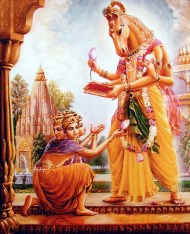 Hayagriva is a guise/avatar of the God Vishnu. The early Indus Valley population venerated Hayagriva as the deliverer of the Vedanta and horses in general for their speed, strength and intelligence.
Hayagriva is a guise/avatar of the God Vishnu. The early Indus Valley population venerated Hayagriva as the deliverer of the Vedanta and horses in general for their speed, strength and intelligence.
Ancient seals of the Indus Valley population already depict the Unicorn as we still know it.
Roman
Since Latin poet Virgil was the first to mention them, Hippogriffs might just be of Roman origin. However, Hippo is Greek for horse but griff comes from Roman gryph for griffin.
The October Horse was the annual sacrifice of a horse to the God Mars.
Mongolian
 The soul of a person is referred to as wind-horse.
The soul of a person is referred to as wind-horse.
Ksaya Tngri is an equestrian deity protecting souls and earthly riches.
The horse of a Mongolian “Robin Hood” figure lifted itself and his master off the earth and flew across a river when they were pursued by lawmen.
Slavic
The God Svantovit owns a white horse.
Chinese
 Horse is part of the Chinese zodiac. Horses in general play an important role in Chinese mythology. Langma is the “dragon horse” and Tianma is a type of Chinese Pegasus for example.
Horse is part of the Chinese zodiac. Horses in general play an important role in Chinese mythology. Langma is the “dragon horse” and Tianma is a type of Chinese Pegasus for example.
Swedish (contemporary)
 In Sweden the Dalahästar, the crafty and beautifully painted wooden horses from the Dalarna region are popular souvenirs and are usually found in standard Swedish homes as well.
In Sweden the Dalahästar, the crafty and beautifully painted wooden horses from the Dalarna region are popular souvenirs and are usually found in standard Swedish homes as well.
English (contemporary)
The Red Vale Horse is a work of art first recorded in the 16th century and maintained until this day. It is similar to the White Horse Hill mentioned earlier in this post. The only difference is that instead of using white chalk, red clay was used.


